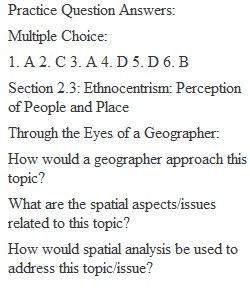


Q Section 2.3: Ethnocentrism: Perception of People and Place Through the Eyes of a Geographer: How would a geographer approach this topic? What are the spatial aspects/issues related to this topic? How would spatial analysis be used to address this topic/issue? What are the where and why questions? How can this topic be studied and analyzed using the five themes of geography? Overview: Ethnocentrism, which is present in varying degrees throughout the world, is the tendency to consider one’s own culture as the “norm” and to judge others by the standards of one’s own culture. Furthermore, when the other group does not “measure up” they are considered inferior, and one’s own group is considered superior. Geographers are interested in the spatial variation of ethnocentrism at all scales and want to understand how humans perceive other people and other places. The United States is typically considered a nation that possesses a high degree of ethnocentrism. The belief that “We’re number one!” reflects the way that most Americans perceive the United States in relation to other people and places around the world. Finally, even within the borders of the United States, ethnocentrism is present. Numerous past and current examples reveal a high degree of ethnocentrism based on beliefs that certain groups comprise the “us” and other groups make up the “them.” Critical Thinking/Discussion Questions: 1. Discuss the role that values and beliefs have in shaping perceptions of people and place. How are stereotypes formed and perpetuated? How do most Americans perceive people and places outside of the United States? 2. Do all Americans perceive one another as equal? Within the United States, who is typically considered as part of the “us” and who is typically considered as part of the “them?” Is ethnocentrism currently increasing or decreasing in the United States? 3. What is ethnocentrism? Is a certain culture “better” than another? How do most people typically perceive people of different cultures? What is xenophobia? Can you provide examples? Practice Questions (Write Correct Answer in Blank): Multiple Choice: 1. ___ The “tendency to judge other cultures by the standards and practices of one’s own” and to consider one’s own culture as the norm is called: A) ethnocentrism B) racism C) superiority D) acculturaltion 2. ___ The author of “Lies My Teacher Told Me” who states that the United States regards itself as “A Nation Without Sin”: A) Pulsipher B) Christopherson C) Loewen D) Kivel 3. ___ Typically, the burden of dispelling negative stereotypes rests with the people: A) being stereotyped B) called children C) creating the stereotype D) of other countries 4. ___ The most extreme expression of ethnocentrism: A) stereotyping B) prejudice C) discrimination D) ethnic cleansing 5. ___ Regarding European contact in the “New World,” the term “explorer” leads people to form a positive perception. The term _____ could be applied to lead people to a different reality and perception: A) learner B) adventurer C) trader D) invader 6. ___ The term “New World” reflects the bias of its source: A) indigenous peoples B) Europeans C) the Mayan People D) academics True or False: 1. ___ The United States has developed an elaborate mythology around certain people and past events. 2. ___ In the United Stares a strong belief existed that “The only good Indian is a dead Indian”. 3. ___ In theory, people are taught in the United States to “always tell the truth.” 4. ___ “Dark” is typically perceived as positive, while “White” is typically perceived as negative. 5. ___ Most Americans typically perceive the terms “Arab” and “African” positively.
View Related Questions